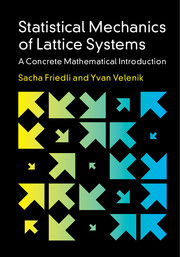Book contents
- Frontmatter
- Dedication
- Contents
- Preface
- Conventions
- 1 Introduction
- 2 The Curie–Weiss Model
- 3 The Ising Model
- 4 Liquid–Vapor Equilibrium
- 5 Cluster Expansion
- 6 Infinite-Volume Gibbs Measures
- 7 Pirogov–Sinai Theory
- 8 The Gaussian Free Field on Zd
- 9 Models with Continuous Symmetry
- 10 Reflection Positivity
- Appendix A Notes
- B Mathematical Appendices
- C Solutions to Exercises
- References
- Index
3 - The Ising Model
Published online by Cambridge University Press: 17 November 2017
- Frontmatter
- Dedication
- Contents
- Preface
- Conventions
- 1 Introduction
- 2 The Curie–Weiss Model
- 3 The Ising Model
- 4 Liquid–Vapor Equilibrium
- 5 Cluster Expansion
- 6 Infinite-Volume Gibbs Measures
- 7 Pirogov–Sinai Theory
- 8 The Gaussian Free Field on Zd
- 9 Models with Continuous Symmetry
- 10 Reflection Positivity
- Appendix A Notes
- B Mathematical Appendices
- C Solutions to Exercises
- References
- Index
Summary
In this chapter, we study the Ising model on Zd, which was introduced informally in Section 1.4.2.We provide both precise definitions of the concepts involved and a detailed analysis of the conditions ensuring the existence or absence of a phase transition in this model, therefore providing full rigorous justification to the discussion in Section 1.4.3. Namely,
• In Section 3.1, the Ising model on Zd is defined, together with various types of boundary conditions.
• In Section 3.2, several concepts of fundamental importance are introduced, including: the thermodynamic limit, the pressure and the magnetization. The latter two quantities are then computed explicitly in the case of the onedimensionalmodel (Section 3.3).
• The notion of infinite-volume Gibbs state is given a precise meaning in Section 3.4. In Section 3.6, we discuss correlation inequalities, which play a central role in the analysis of ferromagnetic systems like the Isingmodel.
• In Section 3.7, the phase diagram of the model is analyzed in detail. In particular, several criteria for the presence of first-order phase transitions, based on the magnetization and the pressure of the model, are introduced in Section 3.7.1. These are used to prove the existence of a phase transition when h = 0 (Sections 3.7.2 and 3.7.3) and the absence of a phase transition when h ≠ 0 (Section 3.7.4). A summary with a link to the discussion in the Introduction is given in Section 3.7.5.
• Finally, in Section 3.10, the reader can find a series of complements to this chapter, in which a number of interesting topics, related to the core of the chapter but usually more advanced or specific, are discussed in a somewhat less precise manner.
Weemphasize that some of the ideas and concepts introduced in this chapter are not only useful for the Ising model, but are also of central importance for statistical mechanics in general. They are thus fundamental for the understanding of other parts of the book.
Finite-Volume Gibbs Distributions
In this section, the Ising model on Zd is defined precisely and some of its basic properties are established. As a careful reader might notice, some of the definitions in this chapter differ slightly from those of Chapter 1. This is done for later convenience.
- Type
- Chapter
- Information
- Statistical Mechanics of Lattice SystemsA Concrete Mathematical Introduction, pp. 82 - 176Publisher: Cambridge University PressPrint publication year: 2017



